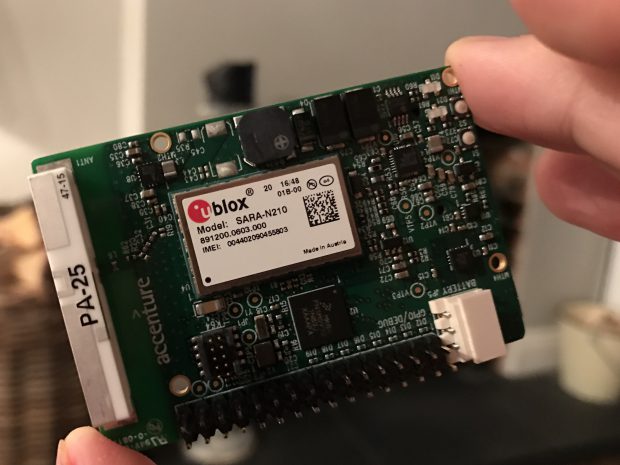Accenture creates IoT device platform in four flavours, demos NB-IoT smart waste collection with Vodafone

Phil Vann, managing directorof Accenture Mobility
The cost of devices and connectivity can make or break an Internet of Things (IoT) business case, but now a professional services firm is working with a Tier-1 network operator to test clients’ use cases before bringing them to market. Jeremy Cowan reports.
Using accelerators like the Accenture IoT Device Platform (AIDP) in its Connected Device Design Studios, Accenture is testing potential use cases for its clients on a variety of networks including LoRa, Sigfox, narrowband-IoT (NB-IoT), Wi-Fi, Bluetooth and cellular.
The tests are said by Accenture to be reducing overall programme costs by showing which technologies will help create innovative solutions offering the right quality of service, bringing them quickly to market and ready to scale.
Working with Vodafone, Accenture claims they are among the first companies to rapidly prototype and test an IoT use case on the operator’s live commercial NB-IoT network.
For example, with the AIDP accelerator tool, Accenture’s Studios have been able to build a ‘smart waste’ solution which went from design through prototyping to testing on Vodafone’s NB-IoT network in less than six weeks.
AIDP is a product of Accenture Mobility. Phil Vann, managing director of Accenture Mobility, told IoT Now, “Accenture have formed the Connected Devices & Embedded Software global practice which I lead out of London. It represents about 1200-1300 engineers.
That allows us to address device manufacturers across a suite of industries. Telecoms is a core part of what we do. We expanded in the early days into automotive, medical equipment, industrial equipment, as well as horizontals like the semiconductor industry, aerospace and defence.
Accenture Mobility has set up a number of device design studios around the globe. As well as paper-based consulting, the company offers rapid prototyping to prove that a technology really does what it says it will do for a particular application. It is also important to see if it meets the commercial needs of that particular device manufacturer or IoT use case.
“We became an ARM Embed cloud partner,” said Vann. “We needed our own prototyping platform to take clients from the advisory stage into a world where we could rapidly prototype new device types, and consider the economics of doing so. We built a roadmap of different AIDP devices, in four brackets; gateways, which comes from technology and clients such as Intel. In that case, we’re adopting OEM devices and modifying those.
When it relates to edge-constrained devices, wearables or ultra-constrained devices there wasn’t anything that would meet our needs. So we started building the first AIDP, which is the edge-constrained version, the big brother of the AIDP suite with all of the functionality.
It’s got a suite of communication protocols; Wi-Fi, Bluetooth, naturally, but also support for the emerging LPWAN technology modules … Sigfox, Ingenu, LoRaWAN, and more recently, Narrowband IoT.”

The Accenture IoT Device Platform (AIDP) and Micro AIDP
The edge-constrained version of AIDP is the size of a small open hardware development platform, like a Raspberry Pi, with all of those technologies pre-integrated.
Accenture Mobility was able to use that to do a number of different prototypes. At Mobile World Congress in 2016, the company created an indoor asset tracking solution using Bluetooth in which it “instrumented” all of the Accenture executives in the hall to understand space utilisation, demo popularity, as well as simple things like ‘Where’s my colleague?’.
It then created a solution at (the UK’s) Farnborough International Air Show last year for an outdoor environment, using GPS and cellular connectivities to track the golf buggies used to shuttle both the staff and guests around the site. “Although we had a close relationship with the organisers that wasn’t really the targeted use case,” says Vann.
“It was more for the aerospace and defence clients that we have, during assembly process working on a very large scale to understand where their vehicles, their assets were, to help with productivity improvements in those environments.
If you think about the increase in aircraft sales and the pressure that puts on Boeing, Airbus, and component vendors in that supply chain; anything that can be done to optimise the assembly process and throughput of those aircraft is significant. Using AIDP as the core, we were able to turn that solution around within seven to eight weeks, starting from nothing to having a deployed solution.”
“There are a number of OEM devices that, on the surface fit the bill for these types of use cases. Often there is a high level of configurability required of that edge device to meet the use case. It could be tuning the power management because it needs to last for a period of time.
It could be about the frequency of positioning. It could be a number of these things but very quickly we find that the OEM devices typically fit a particular purpose and configuring them, customising them – although it’s possible working with that OEM – it doesn’t fit into the mould of rapid prototyping, it tends to be a longer-term engagement to be able to do that.”
AIDP reportedly allows Accenture to find the optimal solution very quickly for a particular use case and then they have two options. “One could be that once we’ve found the optimal solution, we determine that there is an existing device out on the market which perfectly fits the use case and that’s fine.

AIDP micro, the Narrowband IoT version, created for the smart waste demo at Mobile World Congress this year
That’s an okay solution for our clients. In other cases, there isn’t and especially that’s the case that we’re finding in the world of IoT these days,” says Vann. “That all of the use cases have very particular characteristics and therefore AIDP gives us a nice route to the market for that particular niche device.”
This year at Mobile World Congress Accenture Mobility had a smart waste demo on the Vodafone stand, as the operator had just turned on the NB-IoT network in Spain and could demonstrate a number of solutions.
The response was apparently good, with the technology now being ‘real’. “There’s been a lot of anticipation of narrowband-IoT or the 3GPP solutions to the LPWAN problem.
Having it physically working at MWC was a real mental shift for the people that saw the demo, it stopped being an academic (exercise), and became a real-world discussion where there was a physical device that was genuinely connected to the network, that was communicating data, that was starting to demonstrate some of the promises of the technology,” said Vann.
Comment on this article below or via Twitter @IoTGN
